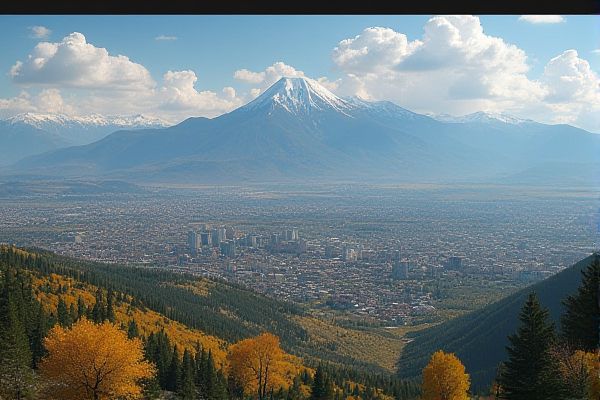
Weather and climate in Montana: Cold, snowy winters. Semi-arid climate east of mountains. Varied temperatures by region. Warm, pleasant summers. Rapid weather changes. Strong winds common. Lower humidity overall. Frequent spring thunderstorms. High-altitude affects climate. Crisp, clear autumns.
Cold, snowy winters.
Montana experiences extreme winter weather, with areas east of the Continental Divide often in deep-freeze conditions, while western Montana can be significantly warmer but still receives substantial snowfall, especially in the mountains. Cold air masses occasionally pass through mountain passes, causing western Montana to become as cold as eastern areas, and Eastern Montana is characterized by blowing snow and high winds.
Semi-arid climate east of mountains.
East of the Continental Divide in Montana, the prairie landscapes experience a semi-arid continental climate characterized by warmer summers, colder winters, and less precipitation. The region receives less moisture due to the Divide's effect on Pacific Maritime air. For more detailed information about how this geographical feature influences the climate, you can visit the Montana Climate website.
Varied temperatures by region.
Montana's climate is notably diverse across its regions, largely due to the presence of the Continental Divide. The western side of Montana enjoys a milder climate, characterized by warmer winters and cooler summers. In contrast, the eastern region experiences intense continental weather, resulting in hotter summers and colder winters. This variation is influenced by local elevation and the state's seven climate divisions. To learn more about these climatic differences and the broader implications of climate changes in Montana, visit the detailed analysis provided by Montana Climate. Overall, the state's unique geographical features create a fascinating climate mosaic, definitely worth exploring.
Warm, pleasant summers.
In Montana, summers are warm but not hot, with temperatures ranging from 70-88°F. June is the best time to visit, with July and August experiencing occasional thunderstorms but generally dry and sunny conditions. The nighttime temperatures often drop into the 40s and 50s. For more detailed climate information, visit the Seasons Year website to plan your perfect trip.
Rapid weather changes.
Montana is experiencing rapid weather changes, including a warming trend that has accelerated over the past 30 years, leading to earlier snow melts, longer and more intense droughts, larger wildfires, and more frequent floods. If emissions are not curbed, the state can expect more extreme weather events, hotter seasons, and significant impacts on water availability and agricultural yields. According to Montana Climate Scientists, these changes will worsen without significant intervention, affecting both the environment and the livelihoods dependent on it.
Strong winds common.
Strong winds are a common occurrence in Montana, particularly with the passage of cold fronts, which can bring sustained wind speeds of 20-40 mph and gusts up to 70-80 mph, especially along the Rocky Mountain Front. According to the KXLH Weather Forecast, these winds can cause significant damage, including broken tree limbs, downed power lines, and blowing debris. It is essential for residents to remain cautious during such weather conditions to ensure safety and prevent property damage.
Lower humidity overall.
In Montana, the overall humidity levels are relatively low, especially in the afternoon. For example, in July, afternoon humidity levels range from 29% in Helena to 35% in Kalispell, indicating a general trend of lower humidity, particularly during the warmer parts of the day. For more detailed information on the state's climate, you can visit the Current Results website to explore how these conditions vary across different regions in Montana.
Frequent spring thunderstorms.
In Montana, spring is characterized by frequent thunderstorms and rainy conditions, particularly in May and June, with the mountains receiving a mix of rain and snow, while the valleys mostly get rain. This period is the rainy season in Montana, helping to prevent forest fires and marked by variable weather with cool air and light spring showers.
High-altitude affects climate.
In Montana, high-altitude areas significantly influence the climate, with the Continental Divide creating a distinct divide between the wetter western region and the drier eastern region. The state's diverse topography, including high mountain ranges, modifies weather systems, leading to cooler temperatures in western Montana and warmer temperatures in the eastern and central parts due to differences in elevation and proximity to the Continental Divide.
Crisp, clear autumns.
In Montana, autumn ushers in crisp and clear weather, with temperatures ranging from 60-70 degrees Fahrenheit in September and October, accompanied by vibrant foliage and occasional thunderstorms. As November arrives, the temperatures transition to a colder range of 18-48 degrees Fahrenheit, reflecting the shift towards winter. For more detailed climate insights, you can explore the weather patterns on the Seasons Year website.
